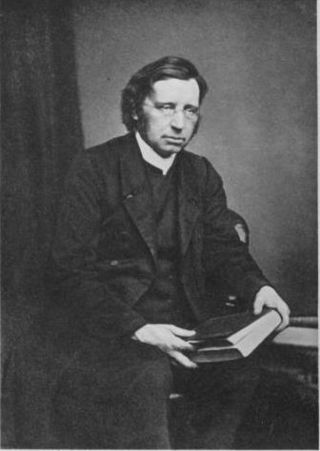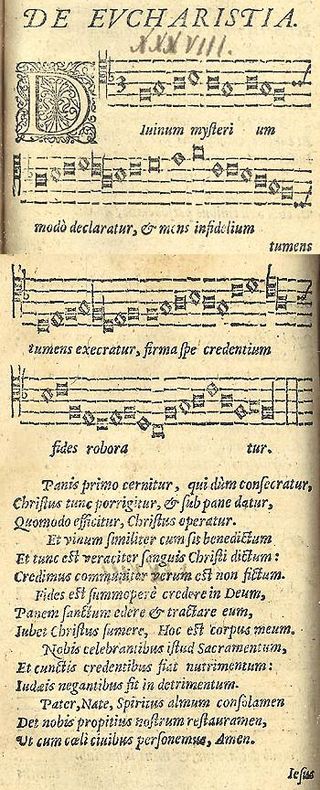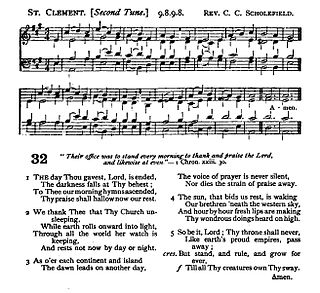
The Te Deum ( or, Latin:[teˈde.um]; from its incipit, Te Deum laudamus is a Latin Christian hymn traditionally ascribed to AD 387 authorship, but with antecedents that place it much earlier. It is central to the Ambrosian hymnal, which spread throughout the Latin Church with other parts of the Ambrosian Rite of Milan in the 6th to 8th centuries. It is sometimes known as the Ambrosian Hymn, although authorship by Saint Ambrose is unlikely. The term Te Deum can also refer to a short religious service based upon the hymn.
A hymnwriter is someone who writes the text, music, or both of hymns. In the Judeo-Christian tradition, the composition of hymns dates back to before the time of David, who composed many of the Psalms. The term hymnodist, in the United States more than in other regions, broadens the scope to include the study of hymns.
"I Vow to Thee, My Country" is a British patriotic hymn, created in 1921 when music by Gustav Holst had a poem by Sir Cecil Spring Rice set to it. The music originated as a wordless melody, which Holst later named "Thaxted", taken from the "Jupiter" movement of Holst's 1917 suite The Planets.
Vexilla regis prodeunt is a Latin hymn in long metre by the Christian poet and saint Venantius Fortunatus, Bishop of Poitiers. It takes its title from its incipit.

John Mason Neale was an English Anglican priest, scholar, and hymnwriter. He worked and wrote on a wide range of holy Christian texts, including obscure medieval hymns, both Western and Eastern. Among his most famous hymns is the 1853 Good King Wenceslas, set on Boxing Day. An Anglo-Catholic, Neale's works have found positive reception in high-church Anglicanism and Western Rite Orthodoxy.
Cwm Rhondda is a popular hymn tune written by John Hughes (1873–1932) in 1907. The name is taken from the Welsh name for the Rhondda Valley.
Urbs beata Jerusalem dicta pacis visio is the first line of a 7th or 8th-century hymn sung in the Office of the Dedication of a Roman Catholic church.

"Recessional" is a poem by Rudyard Kipling. It was composed for the Diamond Jubilee of Queen Victoria, in 1897.
"Veni Creator Spiritus" is a traditional Christian hymn believed to have been written by Rabanus Maurus, a ninth-century German monk, teacher, archbishop, and saint. When the original Latin text is used, it is normally sung to a Gregorian Chant tune first known from Kempten Abbey around the year 1000. The hymn has been translated and paraphrased into several languages, and adapted into many musical forms, often as a hymn for Pentecost or for other occasions that focus on the Holy Spirit.

"Of the Father's heart begotten" alternatively known as "Of the Father's love begotten" is a doctrinal hymn based on the Latin poem "Corde natus" by the Roman poet Aurelius Prudentius, from his Liber Cathemerinon beginning "Da puer plectrum" which includes the Latin stanzas listed below.

O filii et filiae is a Christian hymn celebrating Easter. It is attributed to Jean Tisserand, a Franciscan friar.

Thine Be the Glory, Risen Conquering Son, also titled Thine Is the Glory, is a Christian hymn for Easter, written by the Swiss Protestant minister, Edmond Budry (1854–1932), and set to the tune of the chorus "See, the Conqu'ring hero comes" from the third section of Handel's oratorio Judas Maccabaeus. The hymn is sometimes sung at weddings or funerals.

"Te Splendor" is a Roman Catholic hymn dedicated to Saint Michael, the Archangel. The hymn derives its name from the fact that in Latin it begins with the words: Te splendor et virtus Patris. The hymn is found in the Roman Breviary.

The day thou gavest, Lord, is ended is a Christian hymn written by the Anglican hymnodist the Rev John Ellerton (1826–1893) in 1870 for its inclusion in A Liturgy for Missionary Meetings. It is often sung to the tune of St Clement and its theme focusses on the worldwide fellowship of the church and its continual offering of prayer and praise to God.

"All Glory, Laud and Honour" is an English translation by the Anglican clergyman John Mason Neale of the Latin hymn "Gloria, laus et honor", which was written by Theodulf of Orléans in 820. It is a Palm Sunday hymn, based on Matthew 21:1–11 and the occasion of Christ's triumphal entry into Jerusalem.
"Jerusalem the Golden" is a nineteenth-century Christian hymn by John Mason Neale. The text is from Neale's translation of a section of Bernard of Cluny's Latin verse satire De Contemptu Mundi.

"Ye Choirs of New Jerusalem" or "Sing, Choirs of New Jerusalem" is an English Easter hymn by Robert Campbell. It is a 19th-century translation of the medieval Chorus novae Ierusalem, attributed to Fulbert of Chartres. The text's primary focus is the Resurrection of Jesus, taking the theme of Jesus as triumphant victor over death and deliverer of the prisoners from Hell.

Lucis Creator Optime is a 5th-century Latin Christian hymn variously attributed to St Gregory the Great or Saint Ambrose. It takes its title from its incipit.










